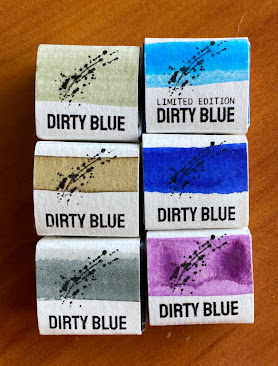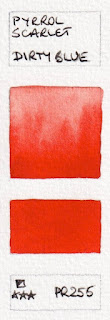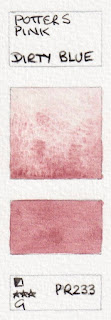


You an even buy pigment jewellery and custom pans in a range of fun shapes, and a swatch stencil. Lots to explore.
I received a mixture of half pans, quarter pans and mini pans of the following colours and have colour-matched them as closely as I can.
PY153 is a discontinued pigment so it's lovely to see this available. Pyrrol Scarlet is my recommended warm red in a palette. This is a rich and deep version of YInMn Blue. Phthalo Cyan is a gorgeous blue, and a rarely seen pigment. Manganese Blue is hardly available anywhere any more, and this is a terrific and rich example of this cool granulating blue.





 Dirty Blue Watercolours: Indian yellow, Pyrrol Scarlet, Ultramarine Pink, YInMn Blue, Phthalo Cyan, Manganese Blue.
Dirty Blue Watercolours: Indian yellow, Pyrrol Scarlet, Ultramarine Pink, YInMn Blue, Phthalo Cyan, Manganese Blue.
These colours are more standard, but nice versions of each.
Dirty Blue Watercolours: Turquoise Cobalt, Green Earth, Oxide Green, Green Gold, Yellow Ochre
Genuine Quinacridone Gold is no longer available from any of the big manufacturers. This version is more orange than the previous genuine PO49 but is a lovely colour. The Burnt Sienna has some wonderful granulation, as does Potter's Pink. The Dirty Blue signature colour is a fascinating greenish bluish grey.
Dirty Blue Watercolours: Quinacridone Gold, Burnt Sienna, Potter's Pink,Green Umber, Dirty Blue Signature colour.











Happy New Year!
ReplyDeleteAnd many thanks for your reviews! Love reading them ❤️
Happy New Year Jane. Thanks for this heads up. See you in Aukland!!!
ReplyDeleteLooks like the PO49 is probably the Guerra pigments version. Not very similar to the old Daniel Smith version. More closely resembles the PO48 quin burnt orange I think. Not sure if it's still available, but you could buy that pigment from Guerra in New York up until pretty recently I believe.
ReplyDeleteIt's from a dry pigment, as far as I know Guerra only had it in dispersion form. Could be from the same manufacturer though..
DeleteWasn't that PB 33 pigment very harmful for the environment to make and/or rather toxic for humans to handle?
ReplyDeleteThere are plenty of toxic pigments that have been produced in huge volumes, like lead/zinc/strontium chromates and molybdates. I don't know why every time PB 33 is mentioned this stuff about how it was manufactured always comes up. The issue with PB 33 is that it has soluble barium. Other pigments used by artists have soluble heavy metals, like PV 14 (soluble cobalt), PB 35 (soluble cobalt), PG 19 (soluble cobalt), PY 157 (soluble barium), and PY 40 (soluble cobalt). Artists have to treat paints with soluble metals responsibly. Don't put brushes in your mouth, et cetera. It is certainly possible to manufacture any pigment responsibly. PB 33 was mainly used industrially to color concrete, I think. Its loss is really unfortuanate for watercolorists because the phthalo imitations aren't very good. And, as far as toxicity, a thing a lot of people don't know about is how PG 7 now is often again highly contaminated with PCBs.
Delete